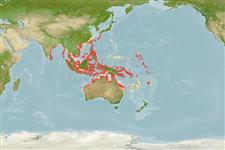Common names from other countries
Classification / Names / Names
Common names | Synonyms | Catalog of Fishes (gen., sp.) | ITIS | CoL | WoRMS
Environment: milieu / climate zone / depth range / distribution range
Ecology
Benthic; depth range 1 - 30 m (Ref. 349). Tropical; 31°N - 29°S, 79°E - 180°E
Indo-Pacific: from East Africa, to eastern Melanesia; north to southern Japan and south to northern Queensland and Fiji Islands. Successfully introduced in French Polynesia in the 1960s.
Length at first maturity / Size / Weight / Age
Maturity: Lm ? range ? - ? cm Max length : 22.0 cm SHL male/unsexed; (Ref. 349); common length : 18.0 cm SHL male/unsexed; (Ref. 349)
Extensively used for food, shell jewelry, inlay, and button making. It is the most important commercial species of Turbinidae in the tropical Indo-West Pacific. Intensive fishing for the mother-of-pearl trade has drastically reduced many turban populations in recent years. In order to protect existing resources and to increase the possibilities of long-term exploitations, attempts of juvenile production, reintroduction, translocation, and commercial legislation are under way in the area (Ref. 349). Maximum depth from Ref. 75835.
Life cycle and mating behavior
Maturity | Reproduction | Spawning | Eggs | Fecundity | Larvae
Members of the order Patellogastropoda are mostly gonochoric and broadcast spawners. Life cycle: Embryos develop into planktonic trocophore larvae and later into juvenile veligers before becoming fully grown adults.
Poutiers, J.M. 1998. (Ref. 349)
IUCN Red List Status (Ref. 130435: Version 2024-1)
CITES status (Ref. 108899)
Not Evaluated
Not Evaluated
Threat to humans
Harmless
Human uses
Fisheries: commercial
| FishSource |
Tools
More information
Age/SizeGrowthLength-weightLength-lengthMorphologyLarvaeAbundance
Internet sources
Estimates based on models
Preferred temperature
(Ref.
115969): 25.7 - 29.3, mean 28.7 (based on 2558 cells).
Vulnerability
Low vulnerability (12 of 100).
